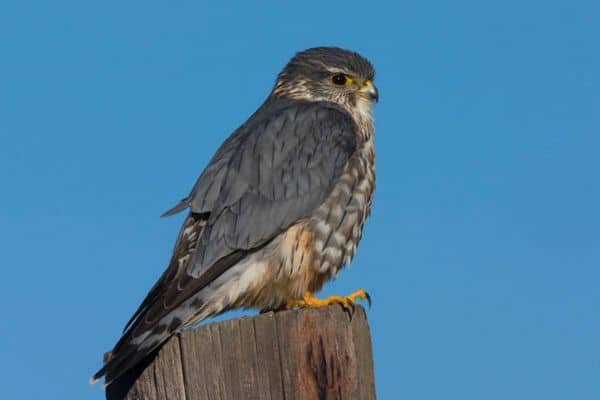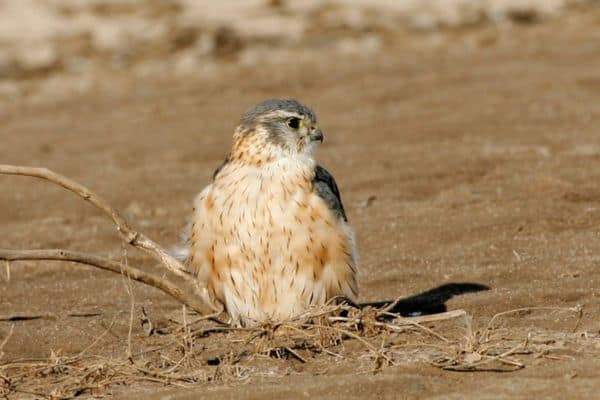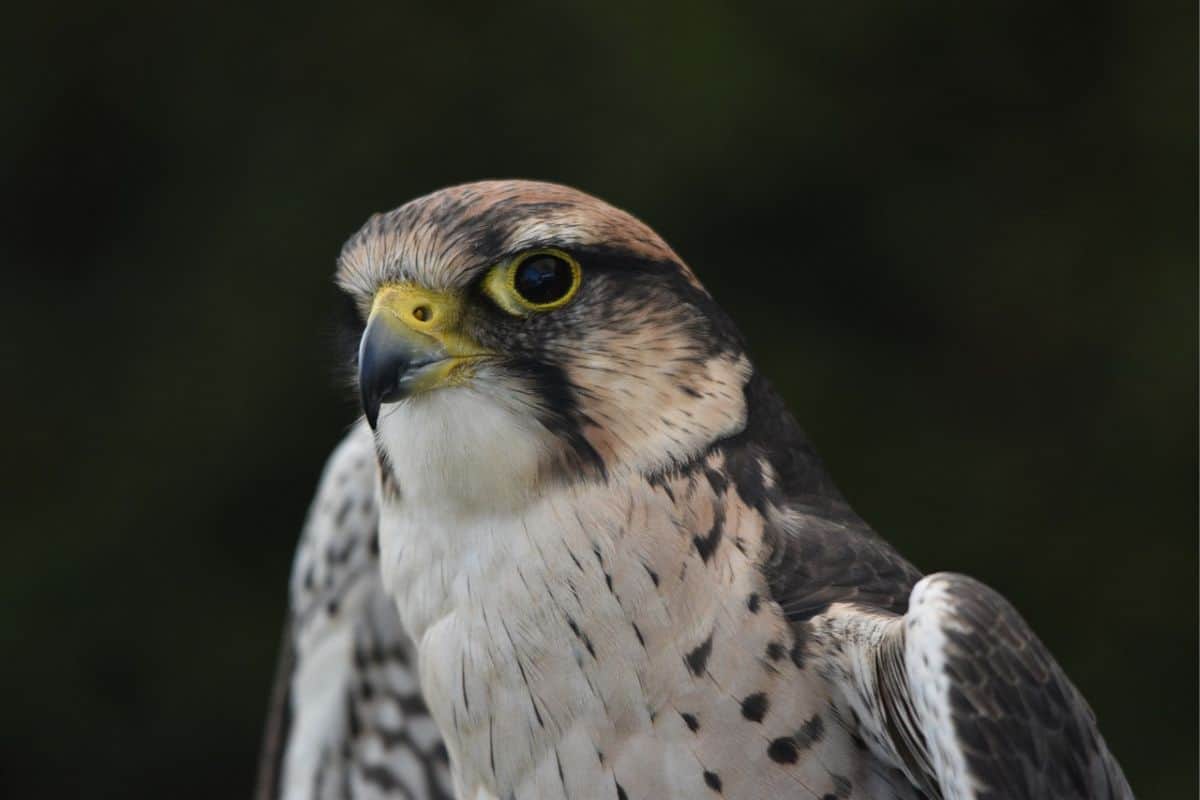Common Name: Merlin
Scientific Name: (Falco columbarius)| Size | Diet | Range in Hawaii | Status in Hawaii |
|---|---|---|---|
| 9 in. - 11 in. | songbirds, shorebirds, pigeons and doves | Midway Island, Kaua'i, O'ahu, and Big Island | Least Concern |
The Merlin (Falco columbarius) is a small but mighty bird of prey that is known for its impressive speed and agility. With its sleek body and sharp talons, this falcon is a formidable hunter that can take down prey larger than itself.
Although it is not a native species to Hawaii, it has been spotted occasionally on the islands, making for a rare and exciting sighting for birdwatchers. In this article, we’ll explore the fascinating world of the Merlin and learn more about its unexpected presence in Hawaii.
Merlin
Appearance

The Merlin is a bird species with a distinctive appearance. It measures approximately 9 to 11 inches in length. It has a compact and robust body, characterized by a relatively short wingspan and a slender, tapered tail.
The adult males typically exhibit dark blue-gray upperparts, while the females and juveniles display a brownish coloration with dark streaks. Both sexes have a pale breast with vertical streaks, and their faces feature a prominent mustache mark.
Diet
The diet of the Merlin primarily consists of small birds. It is a skilled hunter known for its impressive aerial agility and speed. Merlins often pursue their prey in flight, capturing them with precision.
They are opportunistic predators and will target a wide range of avian species, including songbirds, shorebirds, and sometimes even larger birds like pigeons or doves. Occasionally, they may also consume insects and small mammals. The diet of the Merlin is predominantly carnivorous, reflecting its adaptation as a formidable bird predator.
Nesting
Merlins typically build their nests in tree cavities or on cliff ledges. They are known to reuse the nests of other birds, such as crows or hawks, rather than constructing their own from scratch. The female Merlin takes the lead in selecting the nesting site and preparing the nest.
The nest is usually lined with soft materials like feathers or moss to provide comfort and insulation for the eggs. The female typically lays a clutch of 3 to 5 eggs, which she incubates for about 28 to 32 days. Both parents take turns incubating the eggs and caring for the hatchlings.
The young Merlins, known as eyasses, remain in the nest for around 25 to 30 days before they fledge and start developing their flying skills. The nesting period for Merlins is an important time for parental care and ensuring the survival of their offspring.
Behavior

The Merlin is a bird species known for its bold and active behavior. It is an agile and swift hunter, often seen in fast, low flight as it pursues its prey. Merlins display remarkable aerial maneuvers, including rapid twists and turns.
They are highly territorial birds, fiercely defending their nesting sites and hunting grounds. During courtship displays, the male Merlin performs acrobatic flight patterns to impress the female. Outside of the breeding season, they are solitary birds, but they may form small flocks during migration.
Merlins are known for their stealthy hunting techniques, often ambushing their prey from concealed perches. They have a strong instinct for survival and are capable of adapting their hunting strategies to various environments. Overall, the Merlin exhibits a fascinating blend of agility, aggression, and adaptability in its behavior.
Habitat
The Merlin is a versatile bird species that can be found in a variety of habitats across its range. During the breeding season, it is commonly found in open areas with scattered trees, such as grasslands, moorlands, or tundra.
It also frequents forest edges and clearings. In the winter months, Merlins can be seen in a wider range of habitats, including coastal areas, marshes, agricultural fields, and even urban environments.
They have the ability to adapt to different landscapes as long as suitable prey is available. The key habitat requirements for Merlins are open spaces for hunting and perches for observation, making them adaptable and able to exploit various environments.
Range
The Merlin, a migratory bird species, has been documented in the Hawaiian Islands. Sightings have occurred on Midway Island, Kaua’i, O’ahu, and Hawai’i Island.
The species was first recorded in 1991-1992 on Midway Island, followed by subsequent observations in various locations. The Hawaiian Bird Records Committee recognized the presence of the Merlin based on these documented records, despite the lack of photographic or specimen evidence.
Conservation Status

The conservation status of the Merlin is generally considered to be of least concern. It is a widespread and relatively abundant bird species with a large global population. However, certain regional populations may face localized threats.
In some areas, habitat loss and degradation due to agricultural expansion, urbanization, and forestry practices can impact the availability of suitable nesting and foraging habitats for Merlins. Pesticide use may also indirectly affect the species by reducing the abundance of prey species.
Despite these challenges, the overall population trend of the Merlin is currently stable, and it is not considered globally threatened. Conservation efforts primarily focus on habitat preservation and ensuring the availability of suitable nesting sites and prey resources for this remarkable bird of prey.
Interesting Facts
1. Acrobatic courtship displays
During courtship, male Merlins perform acrobatic flight displays, showcasing their aerial skills to impress the females and strengthen the bond between prospective mates.
2. Nest reuse rather than nest building
Instead of constructing their nests from scratch, Merlins often opt to reuse the nests of other birds like crows or hawks, showcasing their resourcefulness and adaptability.
3. Fierce defense of territory
Exhibiting a highly territorial nature, Merlins fiercely defend their nesting sites and hunting grounds, ensuring the protection of their vital resources.
4. Impressive hunting skills and flight agility
Merlins are renowned for their remarkable hunting prowess and agility in flight. They engage in fast, low flights, executing rapid twists and turns as they pursue their prey with precision.
Frequently Asked Questions
1. What is the lifespan of a Merlin?
The average lifespan of a Merlin in the wild is around 5 to 10 years. However, some individuals have been known to live up to 15 years.
2. Are Merlins aggressive towards humans?.
Merlins are generally not aggressive towards humans unless they feel threatened or their nesting territory is invaded. It’s best to observe them from a respectful distance to avoid causing distress.
3. Are there different subspecies of Merlins?
Yes, there are several recognized subspecies of Merlins, including the Eurasian Merlin (F. c. aesalon) and the North American Merlin (F. c. columbarius). These subspecies exhibit slight variations in size and plumage characteristics.




